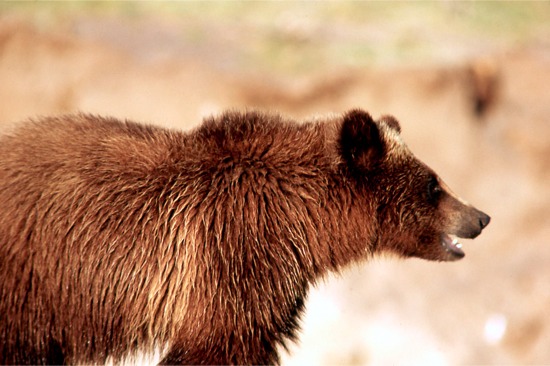American Indians in the U.S. West are protesting a possible move to lift protections on Yellowstone grizzly bears.
Reportedly, officials are mulling a lift after finding bear populations “stable,” a move that’s garnered vocal support around Park County. Tribal representatives are voicing their own concerns, citing the importance grizzlies bear on their cultural heritage, past and present. From the Missoulian:
A former chairman of Arizona’s Hopi Tribe, Ben Nuvamsa, says his people regard the grizzly as an “uncle” who possesses strong healing powers and plays a central role in traditional ceremonies. He said tribes want to “keep it from being a trophy animal and prevent the industrialization of bear habitat.”
“We regard him as part of our family, and it’s really important to all of us natives to keep him around,” Nuvamsa added. “It doesn’t matter where the bears are. We pray to them when we see them.”
Although no formal proposal has been put forward to delist Yellowstone grizzly bears, state officials have expressed interest in assuming management responsibilities and instituting a limited trophy hunt. No other grizzly population (including the estimated 1,000 around Glacier National Park) is facing such scrutiny right now.
As of writing, the Greater Yellowstone Ecosystem grizzly bear population is estimated at around 700 to 1000, a number some officials (at the federal level as well as Montana, Idaho and Wyoming state level) say passes the “recovered” threshold. Protections on Yellowstone grizzly bears were previously lifted in 2007 but were later reinstated in 2009 over concerns that bears weren’t finding enough forage for winter. Currently, federal biologists contend grizzly food sources are not threatened by climate change and say some protections would stay in place.
It’s a sensitive issue, of course, delisting Yellowstone grizzly bears, with many stakeholders conflicted over what constitutes a recovered population and whether grizzly bears should even be allowed to roam around so freely. For tribal governments, the issue hits especially close to home, as the historic range of grizzly bears coincided with ancestral Indian ranges. From the Missoulian:
U.S. Fish and Wildlife Service spokeswoman Serena Baker says the agency will try to balance the tribes’ concerns against science that shows the grizzly bear population has rebounded in the Yellowstone region since protections were imposed in 1975.
Endangered Species Act decisions typically are guided by what’s known under the law as the “best available science,” but Baker said the tribes’ views also would be taken into consideration.
“They have a very deep connection to the land and the animals and the environment,” she said. “We certainly want to respect that.”
But leaders of dozens of tribes across the U.S, most of them west of the Mississippi River, have called for a halt to the process.
They said they have been denied formal consultations over an animal that was once widespread across their ancestral homelands. Consultations on matters affecting tribes are required under treaty obligations and prior White House executive orders.
Grizzly bears lived across much of the West until hunting and trapping eliminated them from more than 98 percent of their historic range in the Lower 48 states.
“These are our treaty lands, our ancestral homelands,” said Shoshone Bannock Tribes Vice Chairman Lee Juan Tyler. “Too many times in our relationship with the federal government we have surprises. … We want the grizzly bear protected with those lands, and the grizzly bear returned to areas where we can co-manage them.”
According to the Missoulian, federal officials have spoken with five tribes in Montana, Wyoming, and Idaho and plan discussions with two more regarding Yellowstone grizzly bears—no information regarding which tribes were approached. Baker added letters have been sent to over 50 tribes—again, no information which tribes are being asked to voice their concerns.
It’s been an interesting year for Yellowstone grizzly bears; one sow, believed to have been Blaze, a bear popular with wildlife photographers/observers, was put down for killing a hiker in August. Her twin grizzly cubs were eventually relocated to the Toledo Zoo. In mid-October, a pair of grizzly twins were relocated after their mother was put down for raiding apple orchards. And overall, grizzly mortalities in the region (human-caused or otherwise) are on the rise this year.
 Yellowstone Insider Your Complete Guide to America's First National Park
Yellowstone Insider Your Complete Guide to America's First National Park





